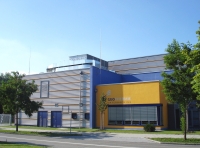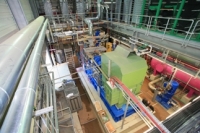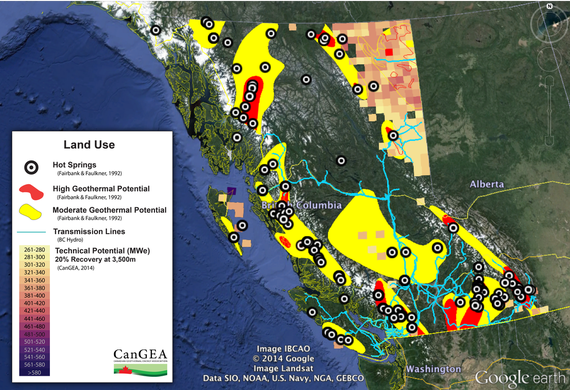British Columbia currently does not use its geothermal resources despite its significant potential. Situated along the Pacific "ring of fire", British Columbia is among the most attractive locations for geothermal energy in Canada. What is preventing geothermal energy from taking root here? Is it technology, economics, or politics?
The classic type of geothermal energy is found in places such as Iceland, where volcanic rock is close to the surface and provides steam to power conventional power plants. The simplest method is known as dry steam where hdyrothermal steam drives a turbine directly. More common today is the flash steam system, where hot hydothermal fluids under great pressure are sprayed into "flash tanks" at considerably lower pressure than the fluid, which cauess some of the liquid to "flash"-vaporize into steam, which in turn drives a turbine. Waste brine from the flash chamber and condensed water from the turbine are re-injected into the ground again. While the majority of existing geothermal plants uses this technology, two new developments may fundamentally change the landscape for geothermal energy.
To date, the most prominent alternative type of geothermal energy system is known as an Enhanced Geothermal System (EGS), which does not require hydrothermal resources. Using highly specialized technology, EGS creates geothermal resources in hot dry rock through "hydraulic stimulation". Cold water is pressurized and injected into deep wells that reach the hot bedrock, and through a second well hot water is brought back to the surface. Unlike "fracking" in the oil and gas industry, EGS does not make use of chemicals or proppants. The pores in the rock are kept open through hydro-shearing as the water circulates continuously through it.
A novel type of geothermal power generation relies on a Hot Sedimentary Aquifer (HSA). These are located in sedimentary basins with elevated heat flow. They tend to be large in volume and offer high natural porosity and permeability. Unlike EGS, they tend to be located a shallower depth and are thus cheaper to develop. They are also naturally wet and thus do not require injection of water. HSA systems can also be developed with conventional technologies.
In British Columbia, several sedimentary basins exist that would support HSA power plants. In the north-est of BC they would share space with gas developments there and could help facilitate the local needs for electricity rather than building new transmission lines. In central and south-eastern BC, HSA power plants could provide reliable base power directly to the grid. Another advantage is the potential use of residual heat for indusrial purposes.
Over the last ten years, geothermal exploration has been conducted in the South German (Bavarian) Molasse Basin. Thermal water had been discovered there decades ago, and has since been used for thermal baths and spa resorts. In the late 1990s, the first geothermal district heating systems were brought online in Erding and Straubing, and since then several more systems have been brought into service near Munich. District heating involves geothermal resources with temperatures between 90°C to 110°C, while combined heat and power (CHP) utilizes temperaturs between 125°C and 150°C.

In Unterhaching, a small city south of Munich in Bavaria, Germany,
a 3.36 MW power plant was commissioned in 2009. The geothermal power plant uses the Kalina
cycle for producing steam (see the animation
at Global Geothermal). Instead of using thermal water directly, the
power plant uses a mixture of ammonia and distilled water, which has a
boiling point of just 50°C. Thermal water from the geothermal
well arrives at a temperature of 122°C and heats up the ammonia
mixture in an evaporator from 55°C to 115°C. The steam powers
 a turbine and exits the turbine still as steam. A water-cooling sytem
condenses the steam into a liquid, and the ammonia mixture is
preheated to 55°C and compressed again before it enters the
evaporator to start a new cycle. Because this type of geothermal plant
involves two cycles (the primary geothermal cycle and the secondary
working-mixture cycle), it is also referred to as a binary-cycle geothermal plant. The plant in Unterhaching actually does more than generate
electricity. In addition to the 3.36 MW electric capacity, it has
a maximal thermal output of 37 MW that is delivered into a
district energy system with a length of 41.5 km, serving
5,000 households.
a turbine and exits the turbine still as steam. A water-cooling sytem
condenses the steam into a liquid, and the ammonia mixture is
preheated to 55°C and compressed again before it enters the
evaporator to start a new cycle. Because this type of geothermal plant
involves two cycles (the primary geothermal cycle and the secondary
working-mixture cycle), it is also referred to as a binary-cycle geothermal plant. The plant in Unterhaching actually does more than generate
electricity. In addition to the 3.36 MW electric capacity, it has
a maximal thermal output of 37 MW that is delivered into a
district energy system with a length of 41.5 km, serving
5,000 households.
BC Hydro has identified 16 locations in British Columbia that are suitable for geothermal exploration. The six most likely projects among them have a combined potential of over 1,000 MW. The South Meager Creek geothermal project north of Pemberton has hydrothermal resources of 260°C with an assessed generating potential of 100 MW. It is owned by Ram Power (TSX:RPG), which currently has operations in the United States and Nicaragua. Other geothermal prospects include Pebble Creat at North Meager (estimated at 300-700 MW) and Mount Edziza in northwestern BC (estimated at 200-800 MW).
The Canadian Geothermal Energy Association (CanGEA) reports in their November 2014 Geothermal Report:
The most conservative estimate of the technical potential of geothermal power from Hot Sedimentary Aquifers in British Columbia is 5,700 MW. This amount is considered achievable with current technology (binary power plants), accessible at relatively shallow depths between 2-3 km, and with the lowest studied recovery factor of 5%. The estimate rises to 8,500 MW when all depths to 4 km in the sedimentary basins are considered. These estimates are calculated according to a Global Protocol and reported following the guidelines of the Geothermal Reporting Code using an NTS grid system, using over 75,000 data points covering 23% of the Province.
The map below identifies the priority geothermal exploration areas in British Columbia. The areas in red are the most promising with high geothermal potential.

Map provided by the Canadian Geothermal Energy Association
CanGEA's full report Geothermal Energy: The Renewable and Cost Effective Alternative to Site C shows that geothermal power has lower levelized energy costs than previously acknowledged by BC Hydro. BC Hydro had put that number at $127/MWh, at which level geothermal energy would be rather uncompetitive. CanGEA maintains that BC Hydro's Resource Options Data (RODAT) is incomplete and based on flawed assumptions. CanGEA's preferred portfolio of geothermal sites, consisting of 8 conventional binary plants from RODAT and 28 HSA plants, could deliver 5,100 GWh/year at an average cost of $73/MWh, less than the projected $83/MWh for the Site C Dam. In addition, the capital expenditure of the geothermal protfolio would be significantly smaller than the comparable cost for Site C: $3.3 billion versus $7.9 billion.
What are the key reasons that have prevented geothermal developments in British Columbia in the past?
- You need a place to sell geothermal power. Without BC Hydro entering into a long-term power purchase agreement with a geothermal power company, there is no other place to go for selling geothermal power.
- Geothermal exploration is risky because of the high upfront cost of drilling. Wells may turn out to be dry. This matters more for geothermal wells than for oil and gas wells because the hydrothermal resource has a much lower energy density than oil and gas (and thus potential profit per cubic meter of what comes out of the ground).
- A lack of research has left geothermal potential unexplored. The Site C Joint Review Panel concluded that “a failure to pursue research over the last 30 years into B.C.'s geothermal resources has left BC Hydro without information about a resource that BC Hydro thinks may offer up to 700 megawatts of firm, economic power with low environmental costs.”
- Without an existing geothermal demonstration project in Canada, it is only possible to point at successful geothermal power plants abroad. This leads to the common observation that conditions in other countries are "different" and not comparable to Canada.
The Globe and Mail also featured an interview with CanGEA's managing director Alison Thompson in its January 4, 2015 issue. Richard Blackwell writes in Geothermal industry stalled in Canada despite bounty of resources: "A lack of government policy support is blamed for keeping the industry from getting started [in Canada]". I agree with Thompson's conclusion that goethermal energy has "nowhere to go but up." Geothermal technology has come a long way in the last few years, and political leaders in Victoria and Ottawa should start taking this technology more seriously. BC is sitting on an unexplored bounty—one that will not wax and wane with the price of oil.
![[Sauder School of Business]](logo-ubc-sauder-2016.png)
![[The University of British Columbia]](logo-ubc-2016.png)